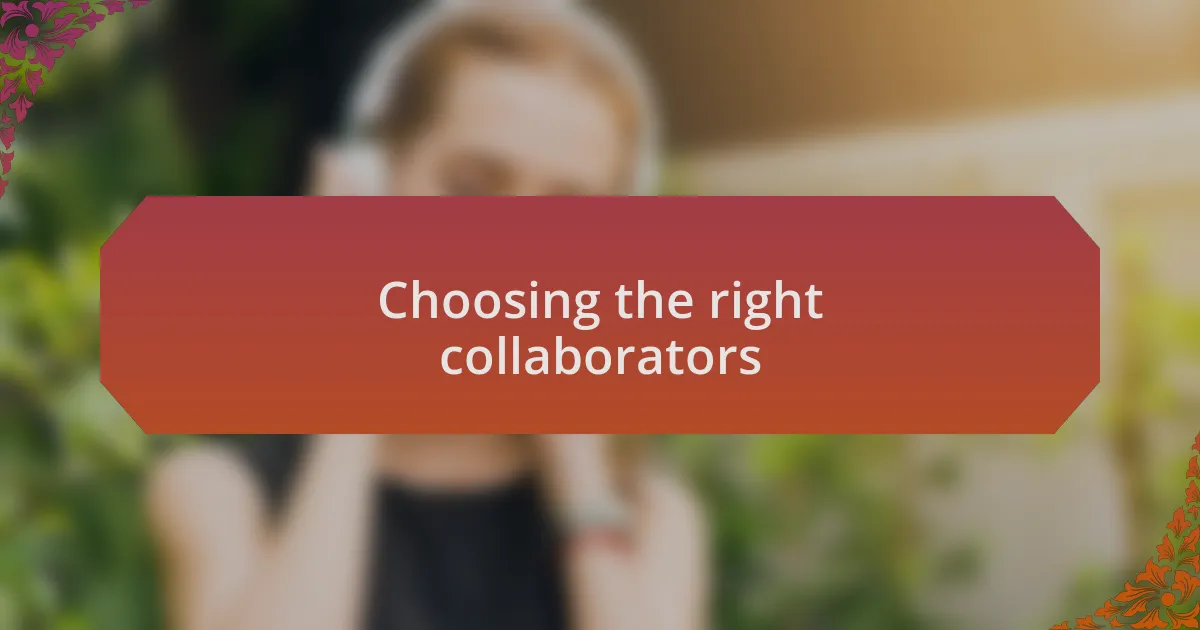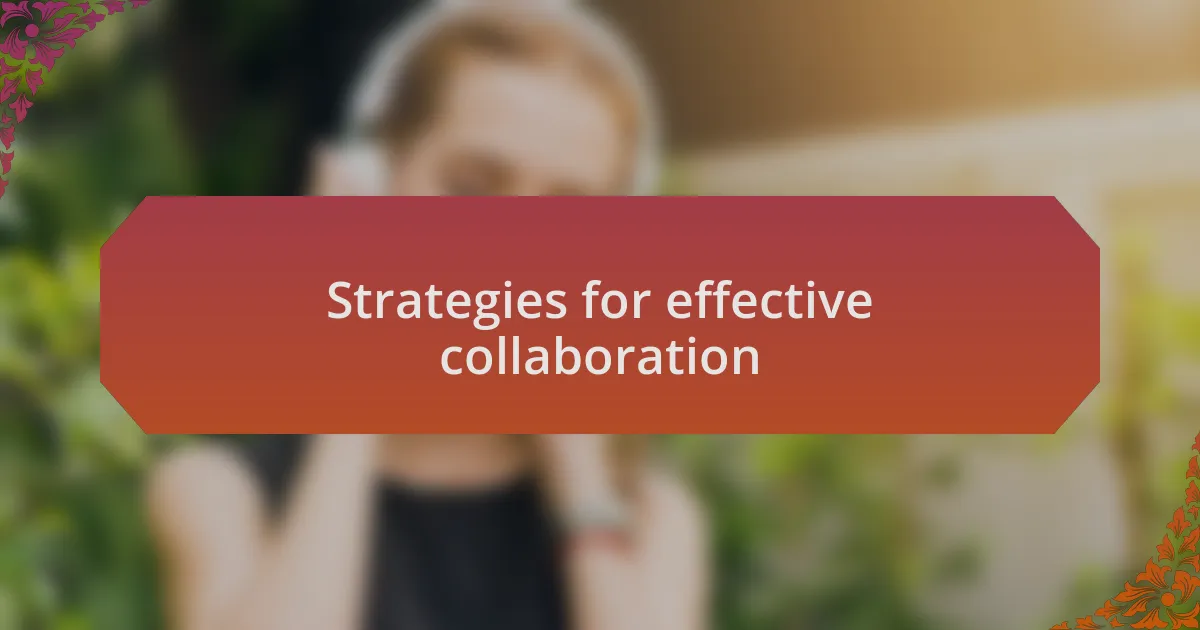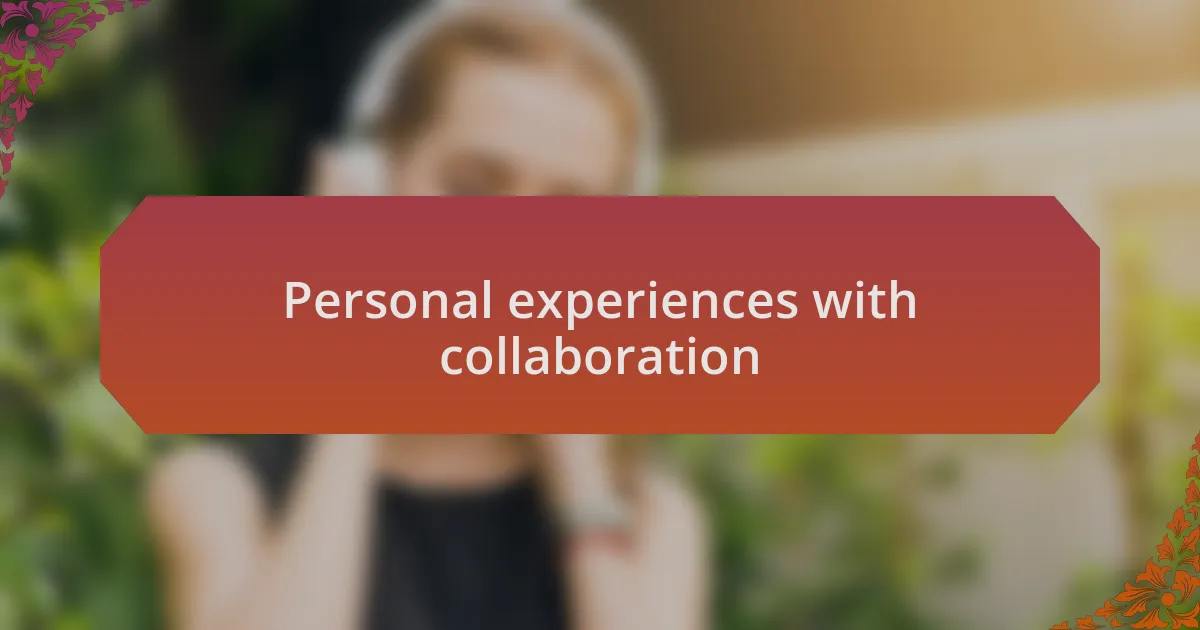Key takeaways:
- Collaboration in the music industry fosters artistic growth by blending diverse perspectives and skills, resulting in richer soundscapes.
- Choosing the right collaborators based on compatibility of vision, work ethic, and diverse skill sets is crucial for successful projects.
- Establishing clear communication and defined roles early in collaboration can enhance creativity and prevent misunderstandings.
- Vulnerability and openness in sharing raw ideas can lead to constructive feedback and unexpected creative breakthroughs.

Understanding collaboration in music industry
Collaboration in the music industry can be a transformative experience. I remember the thrill when I first teamed up with another local artist for a track; the synergy of our different styles led to something far superior to what either of us could create alone. It’s fascinating to think about how blending distinct perspectives can evoke a richer soundscape.
When artists come together, they not only share skills and ideas but also create a unique fusion that resonates with diverse audiences. Have you ever noticed how unexpected collaborations can generate buzz in the industry? Personally, I’ve found that each project unveils new layers of creativity, pushing me to explore sounds and concepts I might have shied away from in isolation.
In my experience, the emotional connection forged through collaboration often leads to profound artistic growth. I once worked with a musician whose life story breathed new meaning into our lyrics; I felt the authenticity of their narrative transform the music. This interplay of personal and artistic narratives not only builds community but also challenges us to think deeply about our own stories and how they intertwine with others.

Importance of collaboration for artists
Collaboration is vital for artists, as it opens doors to new ideas and techniques. I remember joining forces with a visual artist during an album launch; their interpretation of my music through visuals was eye-opening. It made me realize how our distinct disciplines could collaboratively enhance the overall experience for our audience.
Working side by side with others can challenge your perspective and push your limits creatively. I’ve had moments where a co-writer suggested an unconventional chord progression that made me rethink my melodic choices. This kind of exchange isn’t just beneficial; it’s essential for expanding an artist’s palette and finding innovation.
Moreover, collaboration fosters relationships that can lead to long-term partnerships and support networks. Have you ever felt isolated as an artist? I certainly have, but collaborating with others brings a sense of belonging. When we unite our efforts, we not only amplify our voices but also build a community that encourages and uplifts one another in our artistic journeys.

Choosing the right collaborators
Choosing the right collaborators is crucial in shaping the direction of a project. I’ve learned that compatibility in vision and style can significantly enhance the creative process. For example, when I teamed up with a producer who shared my love for experimental sounds, the resulting mix had a depth I hadn’t achieved before. Have you ever found a collaborator who just gets it? That connection can be a game changer.
It’s also essential to evaluate a collaborator’s work ethic and commitment level. I once partnered with someone who seemed passionate at first but lacked follow-through, leading to frustration on both sides. That experience taught me to prioritize not only talent but also dedication and professionalism. How do you assess that in potential partners? I often discuss project timelines and expectations upfront to ensure we’re on the same page.
Lastly, diverse skill sets can create a richer outcome. I vividly remember collaborating with a lyricist whose background in poetry brought a new dimension to my songwriting. This contrast not only elevated the final product but also taught me to appreciate different artistic forms. When considering collaborators, think about how their unique strengths can complement your own; the right mix can lead to unexpected and delightful results.

Strategies for effective collaboration
One effective strategy for collaboration is setting clear communication channels from the start. I once embarked on a project with two other artists, and we established a shared messaging group. This simple move allowed us to bounce ideas off each other in real time and quickly address any concerns. Have you ever experienced miscommunication? It can derail creativity and lead to endless revisions. By keeping the lines open, we cultivated a genuine dialogue that fueled our creativity.
Another strategy is to establish roles and responsibilities early in the process. In one collaboration, I took the lead on production while my partner focused on vocals, but we weren’t clear about our individual tasks. It became chaotic, and we often found ourselves stepping on each other’s toes. I now always suggest a quick brainstorming session to map out who does what, making it easier to respect each other’s space and contributions. How much smoother could your collaborations be with a defined structure?
Flexibility is crucial too. I remember a project where my vision clashed with a collaborator’s idea, and instead of digging in my heels, I chose to embrace a fresh take. This pivot led to an unexpected sound that enhanced the track beyond what I could have imagined on my own. Are you open to new directions? Sometimes, letting go of control can pave the way for magic.

Personal experiences with collaboration
I’ve had some unforgettable experiences with collaboration, especially when working with diverse artists. On one occasion, I teamed up with a visual artist to create a multimedia project. Not only did we push each other’s boundaries, but I also discovered how music and visual art can evoke feelings in ways I hadn’t considered before. Isn’t it fascinating how different perspectives can create something completely new?
Another time, I partnered with a friend whose style was so different from mine. At first, I felt apprehensive—how would our sounds mesh? However, we found common ground in our love for storytelling. I vividly remember one late-night session where we improvised and laughed together, ultimately shaping a song that captured the essence of both our artistic voices. Have you ever found inspiration in unexpected places?
I’ve also learned that trust is a vital component of successful collaboration. During a project, I hesitated to share my raw ideas, worrying they weren’t “polished” enough. But when I finally opened up, it sparked an honest discussion, and my collaborator offered constructive feedback that ultimately enriched the final product. It made me realize that vulnerability can really be a strength in creativity. What might you discover by sharing your unfiltered thoughts?